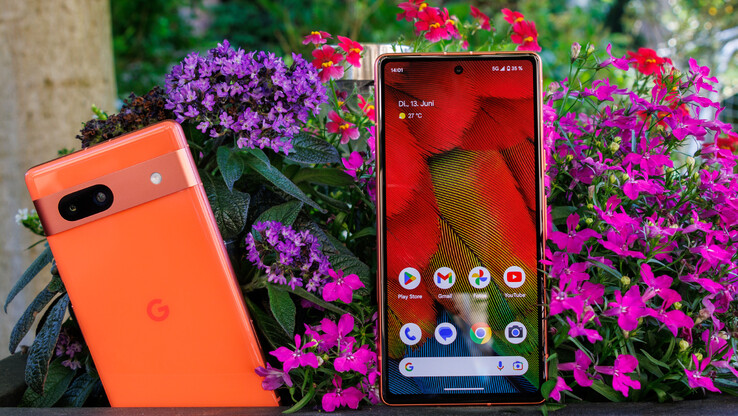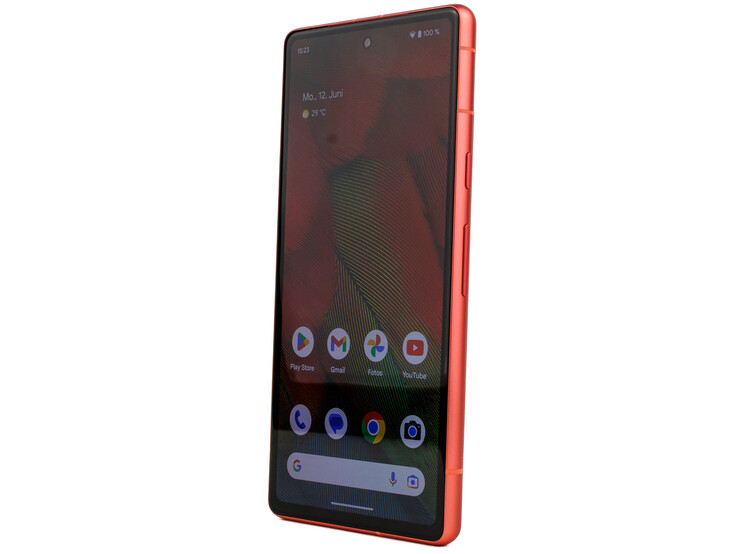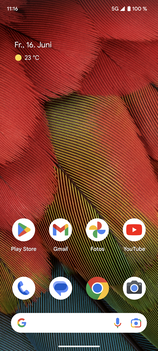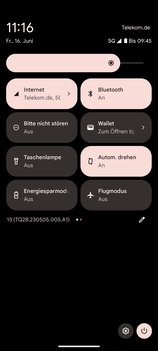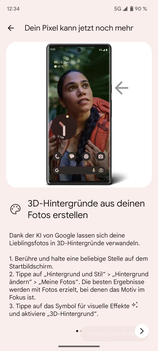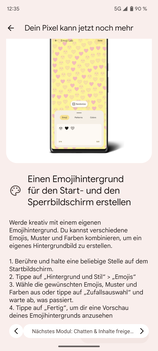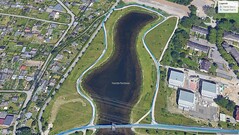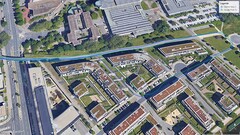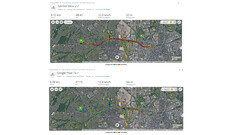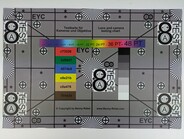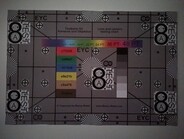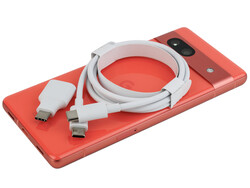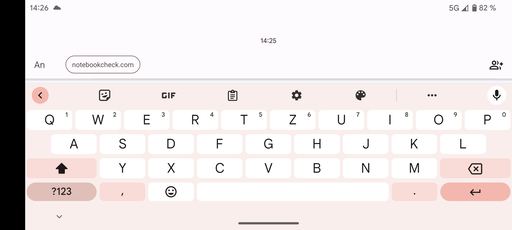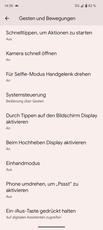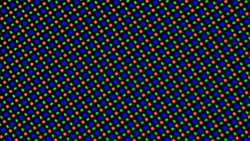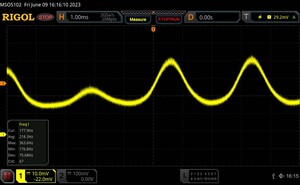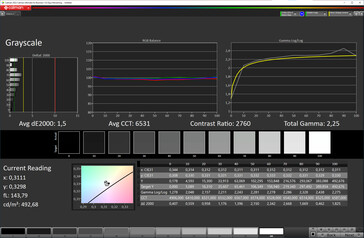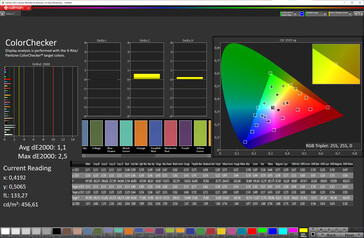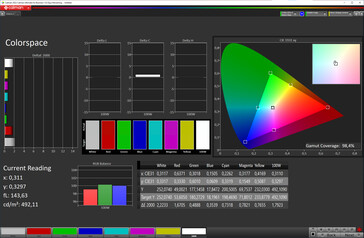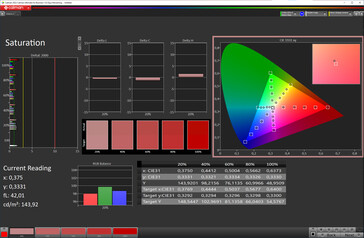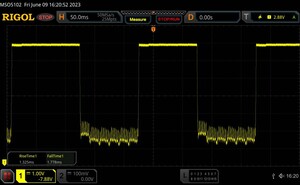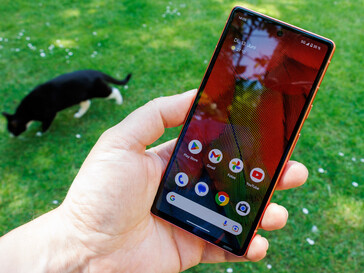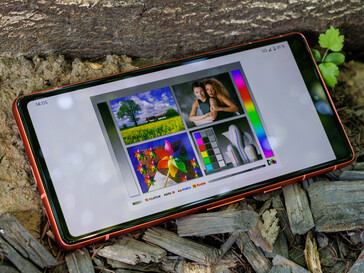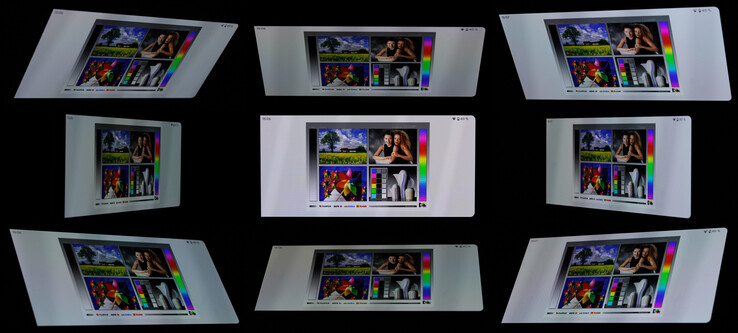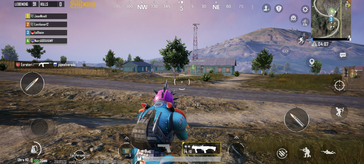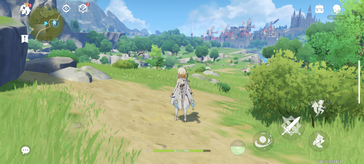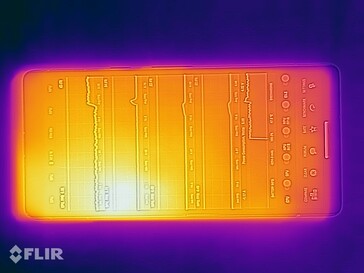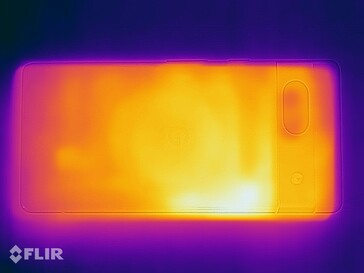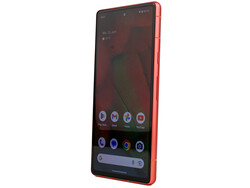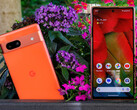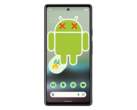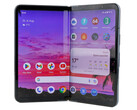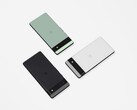Google Pixel 7a review - The near-perfect mid-range smartphone
The Google Pixel 7a is the direct successor to last year's Pixel 6a. As expected, the internet giant's mid-range smartphone has inherited both of its older siblings' SoC - a genuine high-end chipset. Aside from this, Google have improved on a whole lot more: The phone's OLED screen now has a higher refresh rate which will lead to a smoother picture, wireless charging capabilities - and the USB port has been given a makeover, too. This all means the phone isn't too far behind the Pixel 7 now.
The Pixel 7a can be had in a storage variant with 8 GB RAM and 128 GB internal storage, which has an MRSP of $499. This makes it exactly $50 more expensive than its predecessor.
Possible competitors compared
Rating | Date | Model | Weight | Drive | Size | Resolution | Price |
|---|---|---|---|---|---|---|---|
| 87.1 % v7 (old) | 06 / 2023 | Google Pixel 7a Tensor G2, Mali-G710 MP7 | 193.5 g | 128 GB UFS 3.1 Flash | 6.10" | 2400x1080 | |
| 86 % v7 (old) | 05 / 2023 | Samsung Galaxy A54 5G Exynos 1380, Mali-G68 MP5 | 202 g | 128 GB UFS 2.2 Flash | 6.40" | 2340x1080 | |
| 89.2 % v7 (old) | 10 / 2022 | Apple iPhone 14 A15, A15 GPU 5-Core | 172 g | 128 GB NVMe | 6.10" | 2532x1170 | |
| 86.4 % v7 (old) | 04 / 2023 | Xiaomi 13 Lite SD 7 Gen 1, Adreno 644 | 171 g | 256 GB UFS 2.2 Flash | 6.55" | 2400x1080 | |
| 86.8 % v7 (old) | 07 / 2023 | Motorola Edge 40 Dimensity 8020, Mali-G77 MP9 | 171 g | 256 GB UFS 3.1 Flash | 6.55" | 2400x1080 |
Case - The Pixel 7a uses recycled aluminum
The Google Pixel 7a borrows its design from its predecessor, the Pixel 6a - but it is now available in the colors Sea (light blue), Charcoal (black), Snow (white) and Coral. The latter is our test device's color. It has a decent display to surface area ratio of 81 per cent - its bezels, however, are definitely thicker than both of the more expensive models. Even so, the Pixel 7a is a comparatively compact smartphone.
The back of the Google smartphone is now made of a 3D thermally formed plastic, which looks and feels similar to glass. Only when you compare them closely do you notice this material being a little more dull. The front is protected by Corning Gorilla Glass 3 and the aluminum used in the case is 100 per cent recycled.
The phone's build is nice. If you try to twist it, it only creaks a little and there are no visible gaps on the device. Only the back of the case has a slightly bigger gab between the top of the camera module and the frame. The SIM card slot is almost seamlessly connected to the frame and the cover only differs slightly in color from the rest of the case.
The Pixel 7a's battery is firmly integrated into the case and cannot be switched out yourself. The smartphone is IP67 certified - meaning it is dust proof and protected against the occasional submersion in fresh water.
Connectivity - The Google smartphone with a slimmed-down USB port
The spec sheet shows the Google Pixel 7a to have a USB 3.2 Gen. 2 connection, meaning it should support transfer rates of up to 10 GBit/s. In our copying test, however, we measured only 228.27 MB/s, which is about on the same level as slower USB 3.2 (Gen. 1) ports. In comparison: The ROG Phone 7 manages rates of almost 860 MB/s. Although OTG is supported, the phone neither supports NTFS nor exFAT for external storage media. Wired image output is just as difficult using this USB port.
Aside from this, the Pixel 7a continues to only features the bare necessities, including Bluetooth 5.3 and NFC.
Software - The Android phone with long update supply
The Google Pixel 7a comes with Android 13 installed and only with Google's own apps. Many features will already be well-known from the Pixel 7. Safety patches will be rolled out on a monthly basis for five years in total. Furthermore, the Pixel 7a will receive three big system updates, meaning it will still see Android 16.
Communication and GNSS - The Pixel 7a has mastered 6-GHz WLAN
The Google Pixel 7a supports a wide range of mobile frequency bands as well as all the usual standards, including 5G Sub6. In bigger cities, its reception should be fine.
Thanks to its Wi-Fi 6E support, the phone can make use of 2.4, 5.0 and 6.0 GHz WLAN connections. Especially it supporting the comparatively young 6 GHz network is something which is not found in many phones within this price range - usually, only high-end smartphones can do this. However, the Pixel 7 and Pixel 7 Pro still have an advantage over the 7a, as they operate almost twice as fast in this frequency area.
| Networking | |
| Google Pixel 7a | |
| iperf3 receive AXE11000 | |
| iperf3 transmit AXE11000 | |
| iperf3 transmit AXE11000 6GHz | |
| iperf3 receive AXE11000 6GHz | |
| Samsung Galaxy A54 5G | |
| iperf3 receive AXE11000 | |
| iperf3 transmit AXE11000 | |
| Apple iPhone 14 | |
| iperf3 receive AXE11000 | |
| iperf3 transmit AXE11000 | |
| Xiaomi 13 Lite | |
| iperf3 receive AXE11000 | |
| iperf3 transmit AXE11000 | |
| Motorola Edge 40 | |
| iperf3 receive AXE11000 | |
| iperf3 transmit AXE11000 | |
| Google Pixel 6a | |
| iperf3 receive AXE11000 | |
| iperf3 transmit AXE11000 | |
| Average of class Smartphone | |
| iperf3 receive AXE11000 | |
| iperf3 transmit AXE11000 | |
| iperf3 transmit AXE11000 6GHz | |
| iperf3 receive AXE11000 6GHz | |
The Pixel 7a may only support Single Band GNSS, however, it supports all the well-known satellite networks: GPS, Glonass, Galileo, BeiDou and QZSS. Satellite locating is even quite fast inside buildings and the Google phone retains a great signal outside despite its technical limitation.
We compared the Pixel 7a with a Garmin Venu 2 during a bike trip. Surprisingly, the smartphone showed a few weaknesses when it came to tracing our journey and was oftentimes a bit off-course. At the end of the day, this should still prove to be sufficient for everyday navigating.
Phoning functions and call quality
The Google Pixel 7a supports basic features such as VoLTE and WLAN calls - additionally, it supports a feature called "Clear Calling" which supposedly filters out background noises reliably even in loud surroundings.
The Pixel 7a does, in fact, deliver good call quality in practice and it manages to filter out quite a few background noises - even in busy streets. The phone's loudspeaker mode does sound quite good, but its microphone doesn't have the widest reach.
The smartphone has space for one Nano SIM and you can additionally (or alternatively) set up an eSIM.
Cameras - The Pixel 7a features a solid main camera
The Pixel 7a's front-facing camera has been upgraded to 13 MPix - however, with an aperture of f/2.2, it is nominally less light-sensitive than the Pixel 6a. You can record video in Full HD at 60 FPS or Ultra HD at 30 FPS using this lens. Selfies look good thanks to the camera's even lighting and Portrait Mode delivers nice bokeh levels which identify subject and background clearly.
The 64-MPix main camera - featuring optical image stabilization (OIS) - takes great photos too. Unfortunately, they have a slightly different color tint than the Pixel 7 Pro - but in low-light conditions, the difference remains surprisingly small. The phone only features a digital zoom which is capable of 8x enlarging, but unfortunately, the quality starts to deteriorate from the 2x-zoom mark. Its ultra-wide angle lens is also lacking a little: The image edges tend to be a little blurry, and distortions and grain become quite visible.
Using the main camera, videos can be recorded in Ultra HD at up to 60 FPS and in practice, they looked quite good. Although, you can only choose between 30 and 60 FPS - 24 FPS isn't even an option.
Image comparison
Choose a scene and navigate within the first image. One click changes the position on touchscreens. One click on the zoomed-in image opens the original in a new window. The first image shows the scaled photograph of the test device.
Main cameraMain cameraUltra-wide angle5x zoomLow lightIn controlled lighting conditions, the 7a has quite a natural color depiction - none of its DeltaE values reached 10.
Our test chart was depicted nicely - only the corners were a little blurry. The only disappointing thing is that Google don't even make the 64-MPix mode accessible for users - instead, every photo uses pixel binning technology to achieve a total of 16.1 MPix. The same can even be said for optional RAW data.
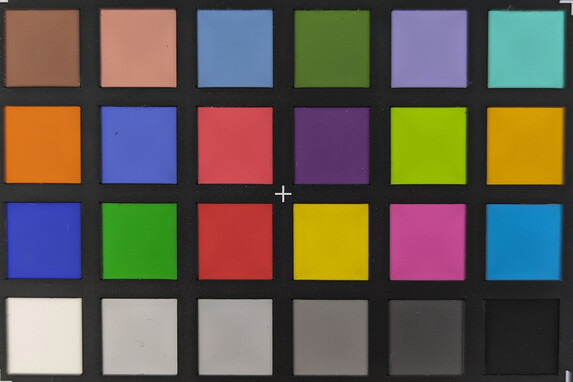
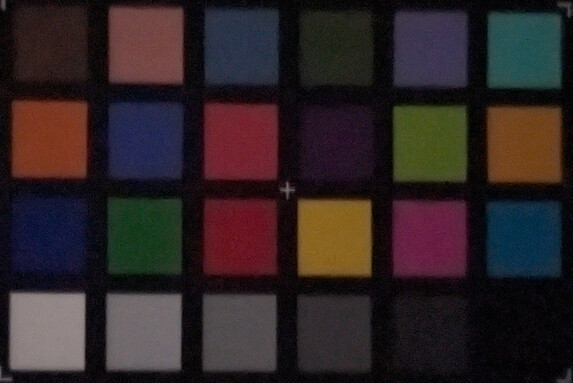
Accessories and warranty - Slimmed-down scope of delivery
In the US, people who purchase the Pixel 7a are entitled to a standard one-year warranty, which cannot be extended. Its scope of delivery remains to be quite slimmed-down. This only includes a USB-C cable, an OTG adapter as well as a SIM tool.
Optional accessories for the 7a include a range of plastic cases in varying colors, a leather case, a transparent case, a matching 30-watt power supply and the Pixel Stand 2.
Input devices & operation - The Pixel 7a features a good vibration motor
The Google Pixel 7a has nice and smooth captive touchscreen protected by Corning Gorilla Glas 3. Inputs are registered quickly and precisely at all times.
Biometric security is taken care of by an optical fingerprint sensor situated within the screen which works reliably and unlocks the phone in no time. Now, you can also switch to using facial recognition through the phone's camera, however, this option is a little less secure.
The device also masters well-known features such as Now Playing, one-handed mode and a limited always-on display, which can give you information on the time and date as well as the weather. The fingerprint sensor's positioning can also be accentuated using AoD, but this uses up more power.
Its linear vibration motor (z-axis) gives solid and precise feedback.
Display - The Google phone has a bright 90-Hz OLED screen
The Pixel 7a's display is 6.1 inches in size and has a resolution of 2,400 x 1,080 pixels. Finally, Google have given their mid-range device a higher refresh rate: 90 Hz. Although, this first hast to be activated within the device's settings (Smooth Display). The phone also supports the HDR standards HLG, HDR10 and HDR10+.
In terms of screen brightness, the 7a even managed to overtake the Pixel 7 (947 cd/m²) - with activated ambient light sensor, the phone achieved an average of 1,010 cd/m² when depicting a pure white screen. With an even distribution of light and dark areas (APL18), the phone achieved values of up to 1,383 cd/m². If you would rather set the brightness manually, then you have access to 486 cd/m².
OLED flickering is quite noticeable on the Pixel 7a - at minimum brightness levels, the phone fluctuates between a restless 177 and 364 Hz, meaning photosensitive users may well have some issues using the phone.
| |||||||||||||||||||||||||
Brightness Distribution: 95 %
Center on Battery: 1006 cd/m²
Contrast: ∞:1 (Black: 0 cd/m²)
ΔE ColorChecker Calman: 1.1 | ∀{0.5-29.43 Ø4.77}
ΔE Greyscale Calman: 1.5 | ∀{0.09-98 Ø5}
98.4% sRGB (Calman 2D)
Gamma: 2.25
CCT: 6531 K
| Google Pixel 7a OLED, 2400x1080, 6.1" | Samsung Galaxy A54 5G Super AMOLED, 2340x1080, 6.4" | Apple iPhone 14 OLED, 2532x1170, 6.1" | Xiaomi 13 Lite AMOLED, 2400x1080, 6.6" | Motorola Edge 40 OLED, 2400x1080, 6.6" | Google Pixel 6a AMOLED, 2400x1080, 6.1" | |
|---|---|---|---|---|---|---|
| Screen | -34% | -19% | -12% | -34% | -7% | |
| Brightness middle (cd/m²) | 1006 | 940 -7% | 835 -17% | 905 -10% | 1023 2% | 758 -25% |
| Brightness (cd/m²) | 1010 | 935 -7% | 841 -17% | 904 -10% | 1042 3% | 767 -24% |
| Brightness Distribution (%) | 95 | 99 4% | 97 2% | 99 4% | 90 -5% | 93 -2% |
| Black Level * (cd/m²) | ||||||
| Colorchecker dE 2000 * | 1.1 | 2.4 -118% | 1.05 5% | 1 9% | 1.6 -45% | 0.9 18% |
| Colorchecker dE 2000 max. * | 2.5 | 3.2 -28% | 2.81 -12% | 3 -20% | 4.3 -72% | 2.5 -0% |
| Greyscale dE 2000 * | 1.5 | 2.2 -47% | 2.6 -73% | 2.2 -47% | 2.8 -87% | 1.6 -7% |
| Gamma | 2.25 98% | 2.05 107% | 2.034 108% | 2.23 99% | 2.27 97% | 2.2 100% |
| CCT | 6531 100% | 6422 101% | 6616 98% | 6382 102% | 6457 101% | 6599 98% |
* ... smaller is better
Screen Flickering / PWM (Pulse-Width Modulation)
| Screen flickering / PWM detected | 218 Hz | ||
The display backlight flickers at 218 Hz (worst case, e.g., utilizing PWM) . The frequency of 218 Hz is relatively low, so sensitive users will likely notice flickering and experience eyestrain at the stated brightness setting and below. In comparison: 53 % of all tested devices do not use PWM to dim the display. If PWM was detected, an average of 8081 (minimum: 5 - maximum: 343500) Hz was measured. | |||
Measurement series with fixed zoom level and different brightness settings
The phone's color depiction and white balance are best tuned using the setting "Natural" and show no reason for critique - the colors show no notable outliers. Using the "Adaptive" mode, the white balance remains similar, but the colors are a little more saturated.
Display Response Times
| ↔ Response Time Black to White | ||
|---|---|---|
| 1.58 ms ... rise ↗ and fall ↘ combined | ↗ 0.7965 ms rise | |
| ↘ 0.781 ms fall | ||
| The screen shows very fast response rates in our tests and should be very well suited for fast-paced gaming. In comparison, all tested devices range from 0.1 (minimum) to 240 (maximum) ms. » 8 % of all devices are better. This means that the measured response time is better than the average of all tested devices (20.2 ms). | ||
| ↔ Response Time 50% Grey to 80% Grey | ||
| 3.1 ms ... rise ↗ and fall ↘ combined | ↗ 1.325 ms rise | |
| ↘ 1.778 ms fall | ||
| The screen shows very fast response rates in our tests and should be very well suited for fast-paced gaming. In comparison, all tested devices range from 0.165 (minimum) to 636 (maximum) ms. » 12 % of all devices are better. This means that the measured response time is better than the average of all tested devices (31.6 ms). | ||
Performance - The Pixel 7a has a Tensor G2
The Pixel 7a uses Google's top-of-the-range SoC from 2022, the Tensor G2, and has 8 GB LPDDR5 RAM.
The phone's performance is similar to that of both the other Pixel smartphones which use this SoC. However, under high load, the Pixel 7a falls short of its big brothers just a bit - presumably due to the SoC's less efficient cooling.
The system speed is nice and smooth thanks to the device's 90-Hz display.
| UL Procyon AI Inference for Android - Overall Score NNAPI | |
| Google Pixel 7a | |
| Google Pixel 7 | |
| Average Google Tensor G2 (37656 - 44323, n=5) | |
| Xiaomi 13 Lite | |
| Motorola Edge 40 | |
| Google Pixel 6a | |
| Average of class Smartphone (3769 - 81594, n=132, last 2 years) | |
| Samsung Galaxy A54 5G | |
The ARM Mali-G710 MP7 delivers good graphics acceleration and leaves its mid-range competitors in the dust. Only the iPhone 14 and iPhone SE's A15-GPU is a little faster.
GFXBench (DX / GLBenchmark) 2.7: T-Rex Onscreen | 1920x1080 T-Rex Offscreen
GFXBench 3.0: on screen Manhattan Onscreen OGL | 1920x1080 1080p Manhattan Offscreen
GFXBench 3.1: on screen Manhattan ES 3.1 Onscreen | 1920x1080 Manhattan ES 3.1 Offscreen
GFXBench: on screen Car Chase Onscreen | 1920x1080 Car Chase Offscreen | on screen Aztec Ruins High Tier Onscreen | 2560x1440 Aztec Ruins High Tier Offscreen | on screen Aztec Ruins Normal Tier Onscreen | 1920x1080 Aztec Ruins Normal Tier Offscreen | 3840x2160 4K Aztec Ruins High Tier Offscreen
| 3DMark / Wild Life Extreme Unlimited | |
| Apple iPhone 14 | |
| Google Pixel 7a | |
| Google Pixel 7 | |
| Google Pixel 6a | |
| Motorola Edge 40 | |
| Xiaomi 13 Lite | |
| Samsung Galaxy A54 5G | |
| 3DMark / Wild Life Extreme | |
| Apple iPhone 14 | |
| Google Pixel 6a | |
| Google Pixel 7a | |
| Google Pixel 7 | |
| Motorola Edge 40 | |
| Xiaomi 13 Lite | |
| Samsung Galaxy A54 5G | |
| 3DMark / Wild Life Unlimited Score | |
| Apple iPhone 14 | |
| Google Pixel 6a | |
| Google Pixel 7a | |
| Google Pixel 7 | |
| Motorola Edge 40 | |
| Xiaomi 13 Lite | |
| Samsung Galaxy A54 5G | |
| 3DMark / Sling Shot Extreme (ES 3.1) Unlimited Physics | |
| Motorola Edge 40 | |
| Google Pixel 6a | |
| Google Pixel 7a | |
| Samsung Galaxy A54 5G | |
| Google Pixel 7 | |
| Xiaomi 13 Lite | |
| Apple iPhone 14 | |
| 3DMark / Sling Shot Extreme (ES 3.1) Unlimited Graphics | |
| Google Pixel 7 | |
| Google Pixel 7a | |
| Google Pixel 6a | |
| Motorola Edge 40 | |
| Xiaomi 13 Lite | |
| Samsung Galaxy A54 5G | |
| Apple iPhone 14 | |
| 3DMark / Sling Shot Extreme (ES 3.1) Unlimited | |
| Google Pixel 7 | |
| Google Pixel 7a | |
| Motorola Edge 40 | |
| Google Pixel 6a | |
| Xiaomi 13 Lite | |
| Samsung Galaxy A54 5G | |
| Apple iPhone 14 | |
| GFXBench (DX / GLBenchmark) 2.7 / T-Rex Onscreen | |
| Motorola Edge 40 | |
| Xiaomi 13 Lite | |
| Samsung Galaxy A54 5G | |
| Google Pixel 7 | |
| Google Pixel 7a | |
| Google Pixel 6a | |
| Apple iPhone 14 | |
| GFXBench (DX / GLBenchmark) 2.7 / T-Rex Offscreen | |
| Apple iPhone 14 | |
| Google Pixel 6a | |
| Google Pixel 7 | |
| Google Pixel 7a | |
| Motorola Edge 40 | |
| Xiaomi 13 Lite | |
| Samsung Galaxy A54 5G | |
| GFXBench 3.0 / Manhattan Onscreen OGL | |
| Google Pixel 7 | |
| Google Pixel 7a | |
| Xiaomi 13 Lite | |
| Samsung Galaxy A54 5G | |
| Google Pixel 6a | |
| Apple iPhone 14 | |
| Motorola Edge 40 | |
| GFXBench 3.0 / 1080p Manhattan Offscreen | |
| Apple iPhone 14 | |
| Google Pixel 6a | |
| Google Pixel 7a | |
| Google Pixel 7 | |
| Xiaomi 13 Lite | |
| Samsung Galaxy A54 5G | |
| Motorola Edge 40 | |
| GFXBench 3.1 / Manhattan ES 3.1 Onscreen | |
| Google Pixel 7 | |
| Google Pixel 6a | |
| Apple iPhone 14 | |
| Xiaomi 13 Lite | |
| Google Pixel 7a | |
| Samsung Galaxy A54 5G | |
| Motorola Edge 40 | |
| GFXBench 3.1 / Manhattan ES 3.1 Offscreen | |
| Apple iPhone 14 | |
| Google Pixel 6a | |
| Google Pixel 7a | |
| Google Pixel 7 | |
| Xiaomi 13 Lite | |
| Samsung Galaxy A54 5G | |
| Motorola Edge 40 | |
| GFXBench / Car Chase Onscreen | |
| Google Pixel 7 | |
| Apple iPhone 14 | |
| Google Pixel 6a | |
| Google Pixel 7a | |
| Motorola Edge 40 | |
| Xiaomi 13 Lite | |
| Samsung Galaxy A54 5G | |
| GFXBench / Car Chase Offscreen | |
| Apple iPhone 14 | |
| Google Pixel 7 | |
| Google Pixel 7a | |
| Google Pixel 6a | |
| Motorola Edge 40 | |
| Xiaomi 13 Lite | |
| Samsung Galaxy A54 5G | |
| GFXBench / Aztec Ruins High Tier Onscreen | |
| Apple iPhone 14 | |
| Google Pixel 7 | |
| Google Pixel 7a | |
| Google Pixel 6a | |
| Motorola Edge 40 | |
| Xiaomi 13 Lite | |
| Samsung Galaxy A54 5G | |
| GFXBench / Aztec Ruins High Tier Offscreen | |
| Apple iPhone 14 | |
| Google Pixel 7 | |
| Google Pixel 6a | |
| Google Pixel 7a | |
| Motorola Edge 40 | |
| Xiaomi 13 Lite | |
| Samsung Galaxy A54 5G | |
| GFXBench / Aztec Ruins Normal Tier Onscreen | |
| Google Pixel 7 | |
| Apple iPhone 14 | |
| Google Pixel 7a | |
| Motorola Edge 40 | |
| Google Pixel 6a | |
| Xiaomi 13 Lite | |
| Samsung Galaxy A54 5G | |
| GFXBench / Aztec Ruins Normal Tier Offscreen | |
| Apple iPhone 14 | |
| Google Pixel 7 | |
| Google Pixel 6a | |
| Google Pixel 7a | |
| Motorola Edge 40 | |
| Xiaomi 13 Lite | |
| Samsung Galaxy A54 5G | |
| GFXBench / 4K Aztec Ruins High Tier Offscreen | |
| Apple iPhone 14 | |
| Google Pixel 6a | |
| Google Pixel 7 | |
| Google Pixel 7a | |
| Motorola Edge 40 | |
| Xiaomi 13 Lite | |
| Samsung Galaxy A54 5G | |
Browsing the web proves to be very fast using the preinstalled Chrome browser. The Pixel 7a also outperformed all Android rivals in our benchmarks.
| Jetstream 2 - 2.0 Total Score | |
| Apple iPhone 14 (Safari 16) | |
| Average of class Smartphone (23.8 - 387, n=147, last 2 years) | |
| Average Google Tensor G2 (96.3 - 117.8, n=5) | |
| Google Pixel 7a (Chrome 114) | |
| Google Pixel 7 (Chrome 106) | |
| Samsung Galaxy A54 5G (Chrome 112) | |
| Google Pixel 6a (Firefox 1ß4-2-ß) | |
| Xiaomi 13 Lite (Chrome 111.0.5563.115) | |
| Motorola Edge 40 (Chrome 114.0.5735.57) | |
| Speedometer 2.0 - Result 2.0 | |
| Apple iPhone 14 (Safari 16) | |
| Average of class Smartphone (15.2 - 643, n=119, last 2 years) | |
| Google Pixel 7a (Chrome 114) | |
| Average Google Tensor G2 (100 - 134, n=5) | |
| Google Pixel 7 (Chrome 106) | |
| Google Pixel 6a (Chrome 105.0.5195.79) | |
| Samsung Galaxy A54 5G (Chrome 112) | |
| Motorola Edge 40 (Chrome 114.0.5735.57) | |
| Xiaomi 13 Lite (Chrome 111.0.5563.115) | |
| WebXPRT 4 - Overall | |
| Apple iPhone 14 (Safari 16) | |
| Average of class Smartphone (27 - 306, n=143, last 2 years) | |
| Google Pixel 7a (Chrome 114) | |
| Average Google Tensor G2 (90 - 111, n=5) | |
| Samsung Galaxy A54 5G (Chrome 112) | |
| Google Pixel 7 (Chrome 106) | |
| Xiaomi 13 Lite (Chrome 111.0.5563.115) | |
| Motorola Edge 40 (Chrome 114.0.5735.57) | |
| Google Pixel 6a (Chrome 105.0.5195.79) | |
| Octane V2 - Total Score | |
| Apple iPhone 14 (Safari 16) | |
| Average of class Smartphone (2228 - 126661, n=194, last 2 years) | |
| Average Google Tensor G2 (43817 - 47939, n=5) | |
| Google Pixel 7 | |
| Google Pixel 7a (Chrome 114) | |
| Samsung Galaxy A54 5G (Chrome 112) | |
| Google Pixel 6a (Chrome 105.0.5195.79) | |
| Motorola Edge 40 (Chrome 114.0.5735.57) | |
| Xiaomi 13 Lite (Chrome 111.0.5563.115) | |
| Mozilla Kraken 1.1 - Total | |
| Motorola Edge 40 (Chrome 114.0.5735.57) | |
| Google Pixel 6a (Chrome 105.0.5195.79) | |
| Xiaomi 13 Lite (Chrome 111.0.5563.115) | |
| Samsung Galaxy A54 5G (Chrome 112) | |
| Average of class Smartphone (257 - 28190, n=154, last 2 years) | |
| Google Pixel 7 (Chrome 106) | |
| Average Google Tensor G2 (920 - 1075, n=5) | |
| Google Pixel 7a (Chrome 114) | |
| Apple iPhone 14 (Safari 16) | |
* ... smaller is better
The Pixel 7a utilizes quick UFS 3.1 storage, which is considerably faster than the one in the Pixel 7. Of the devices we compared, only the Motorola Edge 40 delivered better speeds.
You are unable to expand the phone's storage using a microSD card.
| Google Pixel 7a | Samsung Galaxy A54 5G | Xiaomi 13 Lite | Motorola Edge 40 | Google Pixel 6a | Google Pixel 7 | Average 128 GB UFS 3.1 Flash | Average of class Smartphone | |
|---|---|---|---|---|---|---|---|---|
| AndroBench 3-5 | -51% | -4% | 16% | -16% | -11% | -7% | 46% | |
| Sequential Read 256KB (MB/s) | 1624.39 | 528.32 -67% | 1001.82 -38% | 1876.88 16% | 1312.64 -19% | 1280.81 -21% | 1569 ? -3% | 2235 ? 38% |
| Sequential Write 256KB (MB/s) | 996.44 | 335.39 -66% | 871.96 -12% | 1587.93 59% | 712.94 -28% | 879.39 -12% | 768 ? -23% | 1871 ? 88% |
| Random Read 4KB (MB/s) | 229.44 | 236.23 3% | 277.33 21% | 235.66 3% | 219.53 -4% | 210.47 -8% | 244 ? 6% | 297 ? 29% |
| Random Write 4KB (MB/s) | 263.81 | 70.52 -73% | 301.41 14% | 229.44 -13% | 225.61 -14% | 253.92 -4% | 243 ? -8% | 343 ? 30% |
Games - Not the smoothest despite top-of-the-range SoC
At this stage, we are unfortunately unable to show the usual FPS recordings which we usually do, as every time we tried to do this, the Pixel 7a heated up considerably and crashed.
Even so, we still want to try to describe our impressions. Casual gaming shows to be no problem for the Google smartphone, whereas more complex games such as PUBG or Genshin Impact don't run as easily. While the shooter PUBG was only a little jerky using the highest graphics setting (Ultra HD), the phone struggled a lot more with Genshin Impact. We would suggest limiting the frame rate to 30 FPS, as the game will start to lag during fights if you don't.
Aside from this, the Pixel 7a does a good job at running games in landscape mode - but sometimes, your hand covers the ambient light sensor and the screen suddenly becomes very dark.
Emissions - Weak cooling and still hot
Temperature
In idle mode, the Google Pixel 7a's surface temperatures remained inconspicuous, but under load, they started to rise quite a bit. Although, it must be noted that we have started to switch to using the intensive Burnout benchmark to simulate high loads, meaning these values can only partly be compared. But still, these temperatures can even be reached in everyday use. This is quite warm, but nothing too out of the ordinary.
One thing became apparent during the 3DMark stress test, which we already began to see during the benchmarks: The Pixel 7a's SoC suffers from poor heat dissipation, meaning its long-term performance was considerably worse than more expensive models.
(-) The maximum temperature on the upper side is 48.3 °C / 119 F, compared to the average of 35.2 °C / 95 F, ranging from 21.9 to 247 °C for the class Smartphone.
(-) The bottom heats up to a maximum of 46.7 °C / 116 F, compared to the average of 34 °C / 93 F
(+) In idle usage, the average temperature for the upper side is 28.2 °C / 83 F, compared to the device average of 32.9 °C / 91 F.
3DMark Wild Life Stress Test
| 3DMark | |
| Wild Life Stress Test Stability | |
| Xiaomi 13 Lite | |
| Motorola Edge 40 | |
| Samsung Galaxy A54 5G | |
| Apple iPhone 14 | |
| Google Pixel 7a | |
| Google Pixel 6a | |
| Wild Life Extreme Stress Test | |
| Xiaomi 13 Lite | |
| Samsung Galaxy A54 5G | |
| Motorola Edge 40 | |
| Apple iPhone 14 | |
| Google Pixel 7a | |
| Google Pixel 6a | |
Speakers
The two speakers on the Google Pixel 7a sound quite decent. Of course, bass and precise trebles are lacking, but the performance we observed is good for a smartphone.
Wired headphones can be connected via the USB-C port. Bluetooth 5.3 is available wirelessly, which features some positive surprises in terms of audio codec support. Besides the common codecs SBC, AAC, aptX, aptX HD and LDAC, LC3 and Opus are also supported.
Google Pixel 7a audio analysis
(+) | speakers can play relatively loud (90.4 dB)
Bass 100 - 315 Hz
(-) | nearly no bass - on average 22.7% lower than median
(±) | linearity of bass is average (8.5% delta to prev. frequency)
Mids 400 - 2000 Hz
(±) | reduced mids - on average 5.1% lower than median
(±) | linearity of mids is average (7.1% delta to prev. frequency)
Highs 2 - 16 kHz
(+) | balanced highs - only 4.7% away from median
(+) | highs are linear (4.9% delta to prev. frequency)
Overall 100 - 16.000 Hz
(±) | linearity of overall sound is average (16.4% difference to median)
Compared to same class
» 7% of all tested devices in this class were better, 5% similar, 88% worse
» The best had a delta of 11%, average was 35%, worst was 134%
Compared to all devices tested
» 26% of all tested devices were better, 6% similar, 68% worse
» The best had a delta of 4%, average was 24%, worst was 134%
Samsung Galaxy A54 5G audio analysis
(+) | speakers can play relatively loud (88.7 dB)
Bass 100 - 315 Hz
(-) | nearly no bass - on average 23.2% lower than median
(±) | linearity of bass is average (11.3% delta to prev. frequency)
Mids 400 - 2000 Hz
(±) | reduced mids - on average 6.4% lower than median
(+) | mids are linear (5.5% delta to prev. frequency)
Highs 2 - 16 kHz
(±) | higher highs - on average 6% higher than median
(+) | highs are linear (2.8% delta to prev. frequency)
Overall 100 - 16.000 Hz
(±) | linearity of overall sound is average (17.8% difference to median)
Compared to same class
» 14% of all tested devices in this class were better, 9% similar, 77% worse
» The best had a delta of 11%, average was 35%, worst was 134%
Compared to all devices tested
» 35% of all tested devices were better, 8% similar, 57% worse
» The best had a delta of 4%, average was 24%, worst was 134%
Battery life - Very good, but not quite as expected
Power consumption
The Google Pixel 7a's power consumption was already very low with 90 Hz activated. It only became higher under load - presumably due to the more power-intensive Burnout benchmark.
The Pixel 7a supports fast charging at up to 18 watts, although "fast" is relative, as the Google smartphone needed over two hours for a full charge in our test. The 25 per cent mark was cracked after 20 minutes, the 50 per cent mark after 49 minutes, the 80 per cent mark after 84 minutes and the 90 per cent mark after 94 minutes.
A new feature is that the Pixel 7a now also supports wireless charging.
| Off / Standby | |
| Idle | |
| Load |
|
Key:
min: | |
| Google Pixel 7a 4385 mAh | Samsung Galaxy A54 5G 5000 mAh | Apple iPhone 14 3279 mAh | Xiaomi 13 Lite 4500 mAh | Motorola Edge 40 4400 mAh | Google Pixel 6a 4410 mAh | Average Google Tensor G2 | Average of class Smartphone | |
|---|---|---|---|---|---|---|---|---|
| Power Consumption | -24% | 8% | -17% | -24% | -23% | -57% | -37% | |
| Idle Minimum * (Watt) | 0.62 | 0.75 -21% | 0.6 3% | 0.74 -19% | 0.62 -0% | 0.68 -10% | 0.896 ? -45% | 0.847 ? -37% |
| Idle Average * (Watt) | 0.87 | 1.51 -74% | 0.8 8% | 1.56 -79% | 1.78 -105% | 1.56 -79% | 1.984 ? -128% | 1.446 ? -66% |
| Idle Maximum * (Watt) | 0.95 | 1.62 -71% | 1 -5% | 1.59 -67% | 1.85 -95% | 1.58 -66% | 2.07 ? -118% | 1.63 ? -72% |
| Load Average * (Watt) | 6.11 | 4.91 20% | 5.4 12% | 3.33 45% | 3.02 51% | 5.37 12% | 6.32 ? -3% | 6.95 ? -14% |
| Load Maximum * (Watt) | 11.81 | 8.93 24% | 9.2 22% | 7.59 36% | 8.23 30% | 8.74 26% | 10.8 ? 9% | 11.3 ? 4% |
* ... smaller is better
Power consumption: Geekbench (150 cd/m²)
Power consumption: GFXBench (150 cd/m²)
Runtimes
At 4,385 mAh, the phone's battery is slightly smaller than that of the Pixel 6a, but its runtimes were better in our practical WLAN test with adjusted display brightness (150 cd/m²). Unfortunately, the same can't be said for the other tests. Google will certainly improve on this at some point, as our power consumption measurements showed that there is still a lot of unused potential.
However, the Pixel 7a already delivered very good results in its current state.
| Google Pixel 7a 4385 mAh | Samsung Galaxy A54 5G 5000 mAh | Apple iPhone 14 3279 mAh | Xiaomi 13 Lite 4500 mAh | Motorola Edge 40 4400 mAh | Google Pixel 6a 4410 mAh | |
|---|---|---|---|---|---|---|
| Battery runtime | 36% | 36% | 24% | 26% | 22% | |
| Reader / Idle (h) | 22.1 | 43.2 95% | 44.8 103% | 37.3 69% | 37.9 71% | 31.3 42% |
| H.264 (h) | 20.4 | 25.1 23% | 21.1 3% | 19.8 -3% | 20.6 1% | 22 8% |
| WiFi v1.3 (h) | 13.7 | 15.7 15% | 16.8 23% | 13.7 0% | 15.4 12% | 12.8 -7% |
| Load (h) | 4.2 | 4.7 12% | 4.8 14% | 5.4 29% | 5.1 21% | 6 43% |
Pros
Cons
Verdict - In-house competition
The Pixel 7a's competitors have a lot to live up to, as the Google smartphone has done a lot right. It features a bright OLED screen with accurate color reproduction - and it finally has a 90-Hz refresh rate. The phone's main camera takes great pictures and its battery runtimes are great too - although they do leave a little room for further improvement. Its features are completed by an IP67 certification, wireless charging and long update supply.
The Google Pixel 7a is a strong mid-range smartphone, making competition out of both its friends and foes within higher price ranges.
But even the Pixel 7a cannot escape criticism entirely: On its spec sheet, Google have named the phone's USB port as being 3.2 Gen. 2, however, it is missing a wired image output option and its transfer rates lie more within the range of a slower USB 3.2 (Gen. 1) connection. Furthermore, its OLED flickering is quite noticeable and the phone doesn't utilize any dimming technology to mitigate this. If you were looking forward to the Pixel 7a's fast SoC, you do have to take into consideration a slight limitation due to the phone's weak cooling performance. Its locating properties leave room for improvement, too.
At launch, the Pixel 7 proves to be a good alternative - the Xiaomi 13 Lite and Galaxy A54 both have some advantages which the Pixel 7a is lacking in.
Price and availability
The Google Pixel 7a can be bought directly from the Google Store for $499. Be careful using their trade-in option, as the prices they offer for old devices are sometimes very low. We would recommend comparing prices online first.
Alternatively, the device can be found on Amazon for $489.33
Google Pixel 7a
- 06/16/2023 v7 (old)
Daniel Schmidt
Transparency
The selection of devices to be reviewed is made by our editorial team. The test sample was freely purchased by the author at his/her own expense. The lender had no influence on this review, nor did the manufacturer receive a copy of this review before publication. There was no obligation to publish this review. As an independent media company, Notebookcheck is not subjected to the authority of manufacturers, retailers or publishers.
This is how Notebookcheck is testing
Every year, Notebookcheck independently reviews hundreds of laptops and smartphones using standardized procedures to ensure that all results are comparable. We have continuously developed our test methods for around 20 years and set industry standards in the process. In our test labs, high-quality measuring equipment is utilized by experienced technicians and editors. These tests involve a multi-stage validation process. Our complex rating system is based on hundreds of well-founded measurements and benchmarks, which maintains objectivity. Further information on our test methods can be found here.


